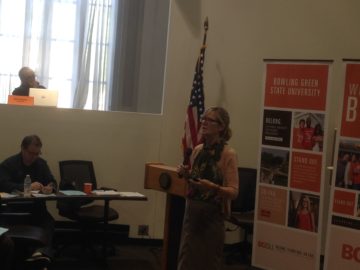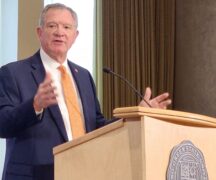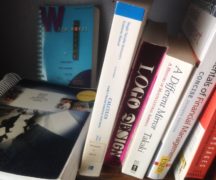By DAVID DUPONT
BG Independent News
No one solution exists for addressing the costs of textbooks.
The Textbook Affordability Committee report to the Faculty Senate recommended a multipronged approach that built on what is already being done at Bowling Green State University and approaches taken at other institutions.
The report was presented to the Faculty Senate Tuesday by Ellen Gorsevski, who chaired the committee.
The senate voted to accept the report and discharge the committee. In a separate vote senators submitted the report to the administration saying it should be used to guide the university’s policy on textbooks.

Ellen Gorsevski presents report on textbook affordability to faculty senate.
BGSU and other state universities have been feeling pressure from Columbus politicians over the costs of textbooks. One proposal that worked its way through the legislative process before being killed would have limited the cost of textbooks to $300 a year and would have required universities to pay for textbooks.
In the end, the legislature left it up to universities to develop policies to reduce the costs of textbooks. “That could change,” Gorsevski said. “This is an evolving issue.”
The problem with these state approaches, Gorsevski said, is that they lacked data to back them up.
How much the “object formerly known as a textbook” costs students and families is hard to determine. Now texts come bundled with digital and online resources, which can drive up the costs.
The committee did some number crunching, but it is still uncomplete. One of its recommendations for the administration is to determine these costs, and then post those numbers so they are easily accessible to students and their families.
What the committee did determine was a cap on spending would result in students in majors with low textbook costs, such as the Humanities, would end up subsidizing those in majors that typically have higher costs, such as the STEM disciplines.
She said that as the committee studied the issue “we discovered many of you are doing a fantastic job.”
The committee came up with “a flexible menu of options” built on what’s already being done.
These include use on “open source” material which is available for free, and giving grants to faculty to develop such material. The committee said the university should consider joining Unizin, a national consortium described in the report as being ““dedicated to improving education technology” including “sharing affordable content, collaborating on digital solutions.”
They also advise faculty to determine as early as possible what textbooks will be required, so students have the most options to finding them. Using older editions, supplementing with new data if needed, can also save students money.
The report also urges those in higher education to educate legislators and the public on the relatively small impact textbooks have on the cost of higher education. They should also sort out what gets lumped in with textbooks, including access to online sites, workbooks and other materials.
In other action, the senate approved the creation of the School of Built Environment within the College of Technology, Architecture and Applied Engineering.
The school would bring together the departments of Construction Management and Architecture.
Wilfred Roudebush, a professor in construction management, said the merger represents changes in industry.
In the past, he said, architects and those who built structures had little contact. Now as the concept of design-build has taken hold in the industry they work closely together.
“The thing I saw is students don’t know what they’re not getting,” Roudebush said.
The creation of the school will not generate additional costs, said interim Dean Venu Dasigi.
A director will be appointed, but the stipend for the director will be less than the combined cost of stipends for the two department chairs. The director will take over the administrative duties of those chairs. If an administrative assistant to the director is hired in the future that would be an additional cost.
Dasigi said the hope is that the new school will attract more students.





